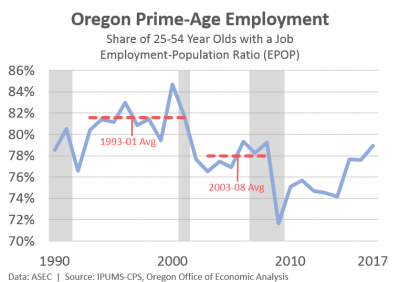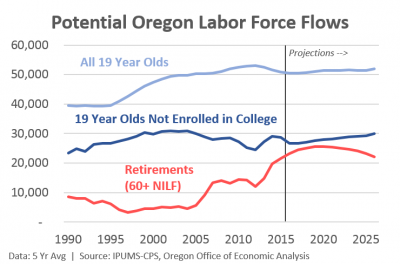The Labor Market Will Remain Tight
by Josh Lehner
Oregon Office of Economic Analysis [6]
The labor market is tight. Difficulty finding (and retaining) workers is the biggest challenge many businesses face today. Whether or not the economy is truly at full employment is largely an academic issue*. In practice, we’re essentially there. This is especially true in Oregon relative to much of the country. However, that also does not mean the labor market cannot get tighter, or it cannot become more challenging to find workers. Furthermore, the tight labor market is expected to remain until the next recession hits and the cycle starts anew. That said, the tight market today is really the result of two different, and independent cycles coming to a head.
The first is the business cycle, which is, err, cyclical. The expansion is in its ninth year, unemployment is flirting with record lows, and we’ve seen the labor force response you would expect. There is no longer a large reserve of potential workers just waiting around for a job. There are some, of course, but the share of the prime working-age population in Oregon that has a job is back to where we were a decade ago. It can go higher still, and we should hope it does. A tight labor market will continue to pull workers back into the economy, and force businesses to dig deeper in the resume stack, as well as increase wages to attract and retain talent. All good things! However, the result is the low hanging fruit of economic slack is gone. The growth moving forward will be slower, and likely more difficult as the economy runs into supply side constraints.
The second cycle impacting the tight labor market is demographics, which are structural. While we’ve known about the demographic imbalances for decades, and our office has built in slower net growth moving forward for quite some time, we’re finally at the point where the crunch is truly happening. Yes, the working-age population in Oregon is continuing to increase. There are more warm bodies available to work, or potentially available to work, however that increase is smaller today due to the uptick in retirements. The large Baby Boomer cohort (now about 54-73 years old) are continuing to age into their classic, or active retirement years. It will be another 15 years or so before the vast majority of Baby Boomers are not longer in the labor force at all. While economic strength ebbs and flows with the business cycle, this demographic crunch will remain throughout the coming decade, possibly two.
In the chart above, I’m using 19 year olds as an example of the intake, or the inflows into the working-age population, to compare it with the outflows of retirements. The labor market is obviously much more complex than this, and adding or losing middle-age workers for different reasons impacts overall economic growth as well. I’m also using 19 year olds because I am doing additional work on the trades, or on classic blue collar occupations and the like. Many of these workers do not attend 4 year universities, as they learn their skills on the job and through apprenticeships. More on that when it’s available, although it will be based on U.S. data due to sample size concerns.
Bottom Line: The labor market is tight and expected to remain so until the next recession. The cyclical issues will come and go, however the demographic crunch is finally upon us and here to stay for the foreseeable future.
* Count me on the “there is still some slack remaining, but it will be increasingly difficult to wring out, but we should still try to get it” side. Or as The Economist’s Ryan Avent likes to say, “try overshooting for once.”

